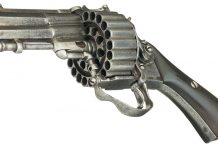It is considered axiomatic that “a gun (or three) is a key factor in a survival situation“. And there is some basis to this concept. When under attack by people who are better armed or significantly outnumber you, proper use of a firearm will often be your best hope of surviving the encounter. Note the word “proper“, it is of critical importance. Improper use of a firearm can REDUCE your chances of survival. Thus, if you wish to incorporate firearms into your survival strategy, you MUST be willing AND able to make the commitment to learn how to use them “properly“. This means allocating time and money for training and practice. Without committing to this and following through, your firearms will not provide you all the benefits they are capable of, and there is a chance they might do you more harm than good.
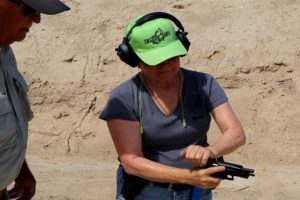

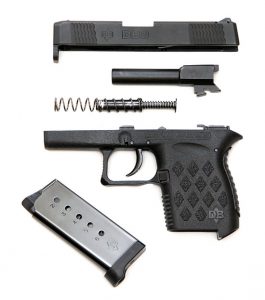

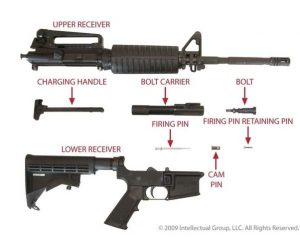

In addition to defense from man or beast, a firearm can be the most effective method of hunting game – at the cost of letting all other game and other people know you are there.
The first step is to force yourself to disregard everything you’ve “learned” about firearms from movies and TV – 92% of it is total crap and will get you killed, or worse.
Safety
Before you ever touch a firearm, you must program the safety rules into every cell in your body and brain. Failing to do so will cause you to issue one of the classic lies and get a trip to the hospital or jail.
Lie 1 – “I didn’t know it was loaded“. Rule 1 is that EVERY gun is ALWAYS loaded. If you believe Rule 1 with every fiber of your being, you’ll never hear yourself saying Lie 1, much less have to pay for it.
Lie 2 – “It just went off“. No it didn’t. You pulled the trigger and it went off. Rule 2 is to never touch the trigger until you are ready to shoot, and if you train yourself to always follow this rule, you are unlikely to hear yourself saying Lie 2 or bear the results. The “unlikely” recognizes that if the firearm is not designed to be safe or has been modified to an unsafe condition, it can go off if dropped or impacted or manipulated. But even in those cases, you dropped it or impacted it or manipulated it, the gun did not just lay there thinking about how boring things were and decided to “go off” just to enjoy some excitement. To make this as unlikely as possible, make sure that you only use firearms which are well designed, built and tested, and are not modified by anyone who does not know what they are doing.
Lie 3 – “I didn’t mean to do that“. In this case, you probably have already uttered Lie 1 and/or Lie 2. But you have shot something or someone, because that was what was in line with the barrel when you violated Rule 1 and Rule 2. This is why there is Rule 3, never point a gun at anything you do not intend to shoot, or at least are not wanting to be shot.
Lie 4 – “I wasn’t aiming at that“. Yes you were. Where your barrel was pointed is where the bullet went. You must be able to verify what you are shooting at AND know that if you penetrate your target or even miss your target, the bullet will continue until it is stopped by something. Rule 4 is always make sure you know that your target is valid AND what is behind your target before firing and that it would not be a disaster to hit the target or anything beyond the target.
If you follow Rule 1, Rule 2, Rule 3 and Rule 4 “religiously“, your odds of being involved in an “accidental” shooting are essentially non-existent.
Morality and Legality
There are those who say “Thou shall not kill“. These are not bad people, but they are also not survivors, perhaps they expect better things in their life after this one, so “don’t mind” not defending themselves in this life. Or just don’t believe anyone would want to harm the wonder that is them. Perhaps a better directive is “Thou shall not murder“.
This recognizes that killing someone without cause is a bad thing, but if someone is attacking you or other innocents without cause, they have forfeited any “right to life” they may have. You need to search your soul and decide which one of these statements is “programmed” into you. If you doubt you could kill someone who is trying to kill you or worse, then don’t have anything to do with firearms. In an armed confrontation, if you hesitate, the attacker is likely to take your gun away from you and kill or “enslave” you. And then use your gun to kill or brutalize others.


If you have to defend yourself, you are guaranteed to have an encounter with Law Enforcement, who tend to look askance at those who “did THEIR job” (which they obviously failed to do). Know the laws, know what to say to the authorities and more importantly, what not to say, and have plans in place for legal representation and bail (because when you are arrested, they take away EVERYTHING you have on you). But what if the situation occurred in a “WROL” (Without Rule Of Law) scenario? Even then, there is a decent chance of consequences. Perhaps Law will be reintroduced in one form or another, and they will look into situations which happened during the period of unrest. Perhaps the person or people who attacked you have friends or family who decide to take “justice” into their own hands. In any case, there is a good chance you will spend a fair amount of time beating yourself up over the situation because for most humans, killing another human is traumatic. Heck, for some people, killing an animal is traumatic. Be fully aware that defending yourself is not without cost, and if you do not think that cost would be bearable or at least preferable to being killed or living with the results intended by your attacker, again, avoid firearms.
Basic Training
Whenever you get a firearm, the first step is to become familiar with it. Read the manual and learn how to operate it, and make sure it functions correctly. Using “snap caps” is a way to try functioning without danger of unintended discharge or damage to the firearm. Make sure you can disassemble it sufficiently to clean it or clear any malfunction, and of course, reassemble it afterwards.
The next step is to learn to hit what you are aiming at and this requires some time at the range. Adjust the sighting mechanism(s) so that the bullet goes where the sights point, and then work on operating the firearm so that you can reliably hit what you aim at. Start at close range and only extend the distance when you are competent at shorter distances. If this is your first firearm, it would be a good idea to load one cartridge at a time, since you need accuracy and consistency to begin with, not speed. It would also be a good idea to have an experienced “coach” to help you out. They can watch what you are doing and help you figure out anything you are doing wrong.
Obviously, you can’t do live fire practice “at home”, if local law enforcement does not object, probably those that live with or near you will. Dry fire is an option, some weapons won’t be damaged by it, and there are “snap caps” designed to prevent dry fire damage to any firearm. Another option is a “laser” TARGET system (NOT an aiming system). This involves installing some sort of laser system in the firearm which shines a laser down the bore briefly when you pull the trigger, and having a target system which detects the laser beam.
Once you can reliably hit “the bullseye”, you can start to work on the other basic skills. You are not likely to be carrying the firearm in firing position all the time. You need to get the firearm from its holster or slung position into firing position, and work on reloads. These are skills which can be practiced at home as well as at the range.
Advanced Training
Once you can properly and effectively use your firearm, you have a good start. However, keep in mind that you will seldom be attacked by pieces of paper, and attackers generally won’t just stand there or move in predictable patterns. As a defender, you don’t want to behave in a “target-like” manner either. You need to incorporate movement and cover into your training. This can be done on your own or with one or more partners, but the most effective option would be formal combat competition. These involve specified scenarios from your starting position to your movement, required cover and mandatory reloads. Your “evaluation” is computed from your time, accuracy, and adherence to the specified sequence of actions. Those with the best scores “win” and everyone else “loses”, which to some degree models real life gunfights. Those who can reach good cover quickly and hit their target soonest, tend to live while their opponents tend to die.
It makes no difference how quick you are if you can’t hit anything and the best accuracy in the world won’t help you if it takes five minutes to line up the shot. And even quickness and accuracy won’t help much if you just stand out in the open. You need to develop the ability to determine and reach good cover (blue plastic barrels are hard to find in the wild, and generally won’t stop a bullet even if you do find one) as well as quickly and accurately hit small targets which may be moving or far away. Furthermore, things have been known to go wrong, so you also need to be able to reload quickly and clear malfunctions.
Search out combat completions reasonably close to you, and get involved on some kind of regular basis. Not only will it extend your skills, but can be fun and challenging.
Another option for training is a course or series of classes. This can be a very good way to learn advanced skills, but the competitions are still a good way to practice them.
“Realism” Training
Combat competition is a good training and/or practice methodology, but the only stress it provides is “time pressure” and the only “punishment” for poor performance is not getting a trophy and perhaps some good natured joshing for a real bonehead mistake. While not without value, this is not optimal training for something on which your life might someday depend. Incorporating some paintball into your training is quite valuable. In this, your targets move and think and *gasp* shoot back at you. And being hit with a paintball won’t kill you, but it will sting like the dickens and leave a nice welt. This game stresses concealment, sneaking, ammunition limitations, gun malfunctions, movement and cover, and even involves some combat strategy. Unlike combat competitions, where you follow a “script” in paintball, you need to come up with your own plan and more importantly, modify that plan as events unfold not as expected. Plus again, this can be quite a lot of fun.
If paintball is not practical in your area, laser tag or airsoft games may provide some of the benefits.
Maintaining Your Skills
Let’s say you do really well at training and reach a level of competence with which you are satisfied. Great! Even if you don’t want to hone your skills further, don’t stop practicing on a reasonably regular basis. As soon as you stop practicing, your skills start to degrade.
What’s Wrong With TV “Training”
As mentioned, if you use TV or movies for training, you will develop some very bad and probably fatal tactics. For instance, entertainment media puts forward that concept that “power flows from the barrel of a gun”. The bad guy points a gun at someone and tells them to do something, and no matter how bad or stupid that something is, the victim does it because the person with the gun “made them”. This is a very bad concept to adopt. To be clear, a gun pointed at you has absolutely no power to control you. The only thing which comes out of the barrel of a gun is a bullet. You may not want to be shot, most people don’t. But as we know from Rule 3, someone pointing a gun at you quite likely intends to shoot you or at least is willing to and just because you do what they say does not guarantee that they WON’T shoot you. React accordingly.
In the same vein, the good guy points a gun at the bad guy and orders him to do something, or argues with him, or lectures him. And the bad guy takes the gun away from him. Again, the gun is to stop them from doing what they are doing, not impose your orders on anyone.
Another thing glorified in entertainment is the concept of a “hostage“. “Drop your gun or I’ll shoot/cut/stab this person” usually results in the good guy disarming himself. I don’t recall ever seeing one saying “Yeah? And the instant you do, there is nothing keeping me from shooting you, is there?” For that matter, combat competitions usually include scenarios where you shoot a “bad guy” target behind one or more “good guy” targets (and you are penalized if you hit a “hostage”). There is nothing magical about a hostage which protects the bad guy from an accurate, resolute good guy. For that matter, how come movie hostages never faint from the stress and fear they are under? It would be instructive to see how the hostage taker could project menace while trying to hold up an unconscious person as a shield.
Then there is the classic “shoot-out“. Good guys behind one set of barricades, bad guys behind another set. People pop up and fire at their opponent’s barricades and duck back down, then someone else pops up and fires; and so on until one side runs out of ammunition. Here’s a hint – the loser in this scenario will always be the one who runs out of ammo first. Lets adopt the policy that you never fire a shot unless you have a reasonable target! One exception might be if you are providing “covering” fire, which should only be done with a very clear understanding of your ammunition situation and what benefits will be realized from the covering fire.
Finally, there is the concept of “always” firing for center of mass. Now this is a very good thing to do for quick results, but it is not magical. If the bad guy happens to be wearing body armor, it will disable them temporarily at best. Think of how many times in the movies a bad guy is “beaten” and then the hero turns away to do something and is attacked again by the bad guy. Even if the bad guy is NOT wearing body armor and IS hit center of mass; there is a chance (the size of which depends on the ammunition they were shot with) they are not permanently incapacitated. That is why two quick shots to center of mass (double tap) followed by an aimed shot to the head is considered the most reliable way to stop an attacker. An attacker who is still armed or even unrestrained should always be considered still a threat.
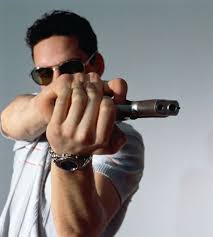

The “gangsta grip” is emphasized, where the gun is held horizontally rather than vertically as designed. Don’t do this. Even if the gun does not jam, you can’t use the sights and the recoil forces are not applied as designed. And then there are the laughable moments when the good guy attempts to continue the battle with his slide locked back. Or he fires 70 rounds out of a gun which only holds 7 and his slide is NOT locked back. Always be aware of the condition of your firearm, and reload when you need to AND during any periods of inactivity. Nothing is worse than having a shot you need to make and just getting a “click“.
The good guy seldom gets hit or if shot (or beaten or knifed), is still capable of heroics. In real life, some bad guys can hit what they aim at, and any one can just “get lucky“. And I suspect that most people are not going to be very effective physically or mentally after being shot anywhere, with anything. So make use of good cover and wise tactics as much as possible, because you don’t have a team of script writers working to ensure that you will meet your goals, and there are no “second takes”.




